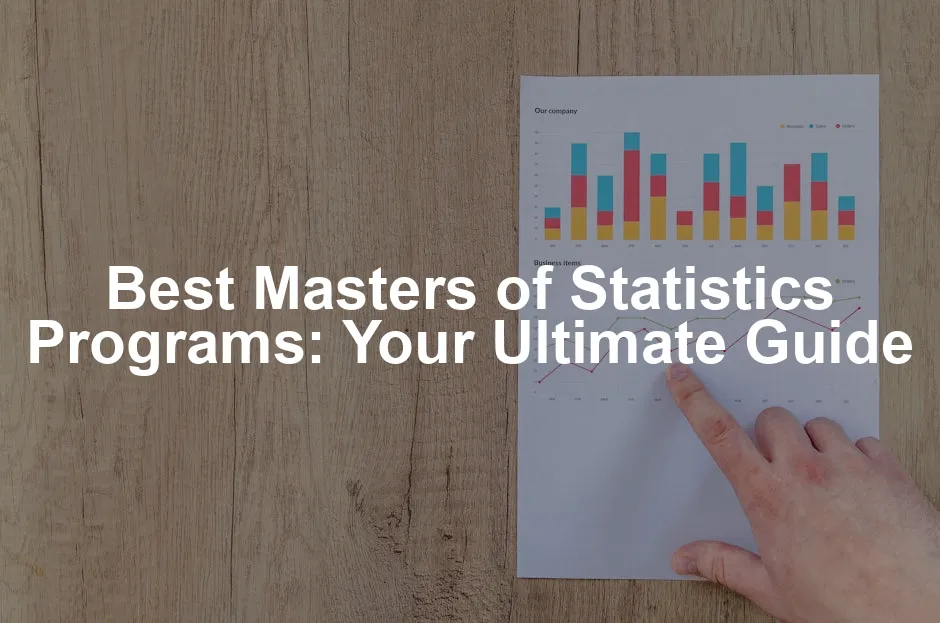Introduction
Pursuing a master’s degree in statistics is more than just a smart choice; it’s a ticket to the future! Statisticians are the unsung heroes behind data analysis, guiding decisions across industries like healthcare, finance, and tech. As businesses increasingly rely on data-driven insights, the demand for skilled statisticians continues to soar. Picture yourself as a data wizard, transforming numbers into stories that can shape company strategies and influence public policies.
This article aims to be your ultimate guide to the best master’s programs in statistics. We’ll sift through the top institutions, program structures, and unique opportunities available to students. Whether you’re a fresh graduate or a career changer, understanding your options is crucial. We want to help you make an informed decision, ensuring you choose a program that aligns with your interests and career goals. So, grab your favorite snack and prepare to embark on this exciting journey through the world of statistics education!

And speaking of snacks, why not fuel your study sessions with a coffee maker? It’s the perfect companion for those late-night study marathons, ensuring you’re always alert and ready to tackle those complex statistics problems!
The Importance of Choosing the Right Program
Selecting the right master’s program in statistics is like choosing the perfect outfit for a big date. You want to impress, feel comfortable, and, most importantly, be yourself. Here are some key factors to consider:
Program Focus: Do you prefer theoretical statistics or applied methods? Some programs emphasize foundational theories, while others focus on practical applications. Choose based on your career aspirations.
Faculty Research Interests: Check out the faculty profiles. Are they engaged in research that excites you? Having mentors whose interests align with yours can enhance your learning experience and open doors to future collaborations.
Location and Networking Opportunities: Is the school in a vibrant city with access to industry hubs? A program located near major companies can provide valuable networking opportunities that might lead to internships or job offers after graduation.
Cost and Funding Options: Let’s be real; tuition can be a deal-breaker. Investigate funding options like scholarships, assistantships, and grants. A little financial planning can go a long way in easing your educational journey.
These factors can significantly impact your career trajectory. For instance, a program with strong industry ties may boost your job prospects. Meanwhile, a school with a robust theoretical focus might prepare you for further academic pursuits, such as a Ph.D. Ultimately, choosing the right program is about finding the perfect fit for your unique goals and aspirations.

And while you’re at it, consider investing in a comfortable ergonomic chair for those long study hours. Your back will thank you, and you’ll be able to focus on the important stuff—like mastering statistics!
How Rankings Are Formed
When it comes to rankings, think of them as the popcorn at a movie—great to have, but not the main event. Various organizations, like US News and QS, use criteria such as faculty credentials, research output, and student satisfaction to compile their lists. However, these rankings can sometimes be misleading.
Different programs excel in different areas, so it’s essential to consider what matters most to you. Maybe you care about job placement rates or alumni networks rather than just the ranking number. Always prioritize personal fit over rankings. After all, a top-ranked program might not be the best choice if it doesn’t align with your career goals or learning style. Explore and research thoroughly, and you’ll find the right program that suits your needs.

And speaking of research, if you want to dive deeper into the world of data, consider picking up a copy of The Art of Statistics: Learning from Data by David Spiegelhalter. It’s a fantastic read that can help you appreciate the beauty of data analysis!
Top Masters of Statistics Programs in the United States
Overview of Top Institutions
Looking to sprinkle some statistical magic on your career? Check out these top-notch master’s programs in statistics across the United States. Each program is a treasure trove of knowledge, offering unique opportunities and a chance to learn from the best in the field. Let’s dive into the details!

1. Massachusetts Institute of Technology (MIT)
– Duration: 2 years
– Format: On-campus
– Specializations: Data science, statistical modeling.
– Notable Faculty: Professors renowned for their work in statistical theory and machine learning.
– Alumni Success: Graduates have landed roles in top tech firms, contributing to groundbreaking data initiatives.
2. Stanford University
– Duration: 2 years
– Format: On-campus
– Specializations: Computational statistics, biostatistics.
– Notable Faculty: Experts in statistical learning and applications in social sciences.
– Alumni Success: Alumni often take high-level positions in Silicon Valley companies and research institutions.
3. Harvard University
– Duration: 2 years
– Format: On-campus
– Specializations: Data science, quantitative social science.
– Notable Faculty: Leaders in biostatistics and health policy.
– Alumni Success: Graduates frequently go on to influential roles in government and academia.

4. University of California, Berkeley
– Duration: 2 years
– Format: On-campus
– Specializations: Environmental statistics, statistical computing.
– Notable Faculty: Pioneers in statistical methodology and big data applications.
– Alumni Success: Graduates work in prestigious research organizations and tech companies.
5. Princeton University
– Duration: 2 years
– Format: On-campus
– Specializations: Statistical theory, applied statistics.
– Notable Faculty: Recognized for their research in probabilistic modeling.
– Alumni Success: Alumni have made significant contributions in academia and industry research labs.
6. Columbia University
– Duration: 2 years
– Format: On-campus
– Specializations: Business analytics, statistical consulting.
– Notable Faculty: Experts in statistical methods for social science research.
– Alumni Success: Graduates often move into prominent roles in consulting firms and financial institutions.

7. University of Washington
– Duration: 2 years
– Format: On-campus
– Specializations: Biostatistics, data science.
– Notable Faculty: Leaders in health statistics and population studies.
– Alumni Success: Graduates work with leading healthcare organizations and tech startups.
8. Johns Hopkins University
– Duration: 1.5-2 years
– Format: On-campus
– Specializations: Biostatistics, data analysis.
– Notable Faculty: Renowned for their contributions to public health and epidemiology.
– Alumni Success: Alumni excel in public health agencies and research institutions globally.
9. Northwestern University
– Duration: 2 years
– Format: On-campus
– Specializations: Predictive analytics, machine learning.
– Notable Faculty: Experts in data-driven decision-making.
– Alumni Success: Graduates frequently work in leading analytics firms and tech companies.

10. Duke University
– Duration: 2 years
– Format: On-campus
– Specializations: Statistical genetics, applied statistics.
– Notable Faculty: Noted for work in health and environmental statistics.
– Alumni Success: Alumni have taken key positions in biotech firms and research labs.
11. University of Chicago
– Duration: 2 years
– Format: On-campus
– Specializations: Financial mathematics, econometrics.
– Notable Faculty: Leaders in economic statistics and quantitative finance.
– Alumni Success: Graduates often enter the finance sector or continue with Ph.D. programs.
12. Carnegie Mellon University
– Duration: 2 years
– Format: On-campus
– Specializations: Operations research, statistical machine learning.
– Notable Faculty: Experts in decision-making under uncertainty.
– Alumni Success: Alumni thrive in consulting and tech industries, driving innovation.

13. University of Michigan
– Duration: 2 years
– Format: On-campus
– Specializations: Social statistics, health data science.
– Notable Faculty: Pioneers in survey methodology and experimental design.
– Alumni Success: Graduates often work in research teams across academia and industry.
14. University of California, Los Angeles (UCLA)
– Duration: 2 years
– Format: On-campus
– Specializations: Statistical genetics, data mining.
– Notable Faculty: Leaders in applied statistics and public health.
– Alumni Success: Graduates have successful careers in academia and health organizations.
15. University of Pennsylvania
– Duration: 2 years
– Format: On-campus
– Specializations: Data analysis, machine learning.
– Notable Faculty: Experts in experimental statistics and data-driven marketing.
– Alumni Success: Alumni have secured roles in prestigious firms and research institutions.

These programs not only offer a strong academic foundation, but they also provide ample research opportunities and networking connections. With faculty members who are leaders in their fields, you’ll gain insights that can set you on the path to success in the dynamic world of statistics. So, pick your program wisely and get ready to crunch some numbers!
And don’t forget to keep your notes organized! A data analysis notebook can be a lifesaver for jotting down your thoughts and calculations as you navigate through your statistics journey!

Top Masters of Statistics Programs in Europe
Overview of European Institutions
When it comes to pursuing a master’s in statistics, Europe is brimming with prestigious institutions. Each program offers unique features, opportunities for research, and internships. Let’s take a closer look at five standout programs that will make your statistical dreams come true!

ETH Zurich
Located in the heart of Switzerland, ETH Zurich is renowned for its rigorous academic standards. The Master in Statistics program emphasizes quantitative methods and computational statistics. Students can engage in cutting-edge research through collaborations with various departments. Internships with Swiss companies and international organizations provide real-world experience. Who wouldn’t want to crunch numbers while surrounded by the stunning Swiss Alps?
University of Oxford
Ah, the University of Oxford! This iconic institution offers a Master of Science in Statistical Science. Students dive into advanced statistical methods, machine learning, and data science. The program is designed with flexibility in mind, accommodating both full-time and part-time students. Research opportunities are plentiful, with access to world-class faculty. Plus, the chance to mingle with fellow nerdy, data-loving Oxfordians is a bonus!
University of Cambridge
Next up is the University of Cambridge, another heavyweight in the education arena. Its Master of Philosophy in Statistical Science focuses on both theoretical and practical aspects of statistics. Students can partake in various research projects, often in collaboration with industry partners. The program also features a robust internship component, allowing students to apply their knowledge in real-world situations. Oh, and did we mention the picturesque views of King’s College?

Imperial College London
Imperial College London stands tall with its Master of Science in Statistics. This program offers a blend of theory and application, ensuring students grasp essential statistical concepts. Unique features include access to modern statistical software and data analysis tools. Research opportunities abound, particularly in health and environmental statistics. With its prime location in London, students have access to numerous internships and networking opportunities. You might even stumble upon a future employer while sipping tea in a trendy café!
University of Amsterdam
Last but not least, the University of Amsterdam offers its own twist on statistical education with its Master’s program in Data Science and Business Analytics. This interdisciplinary program combines statistics, data science, and business insights. Students have the chance to engage in hands-on projects and internships with various industry partners. The vibrant city of Amsterdam adds an extra layer of excitement, making it a lively place to study and explore!

These European institutions not only provide top-notch education but also foster research and internship opportunities. Whether you’re dreaming of conquering the statistics world or just want to add some impressive credentials to your resume, these programs have got you covered!
Career Opportunities After a Master’s in Statistics
Graduating with a master’s in statistics opens up a treasure chest of career opportunities. Whether you’re into data analysis or curious about biostatistics, the job market is ripe for talented statisticians. Here’s a peek into some exciting career paths you can explore:
Exploring various career paths in statistics is essential for understanding the opportunities available. master’s degree in statistics jobs can lead to various roles in different sectors.
Data Analysis: As a data analyst, your mission is to make sense of numbers. Companies in all sectors need professionals to interpret complex data sets. This role involves using statistical tools to identify trends and create actionable insights. It’s like being a detective, where data is your clue!

Market Research: Curious about consumer behavior? Market research analysts study and analyze data about consumers and competitors. They help companies understand what products to sell and how to market them effectively. It’s a blend of statistics and business savvy, perfect for the curious mind.
Biostatistics: If health and medicine pique your interest, consider biostatistics. Biostatisticians work in healthcare, analyzing data from clinical trials and public health studies. Your work could directly influence health policies or new treatments, making a real difference in people’s lives.
Financial Analysis: In the finance world, statisticians are invaluable. Financial analysts utilize statistical methods to evaluate investments, manage financial risks, and forecast economic trends. If numbers make you giddy, this path might just be your calling!

Academia: If you have a passion for teaching and research, academia is a fantastic option. Professors and researchers contribute to the field of statistics by educating future generations and advancing knowledge. Plus, you get to dive deep into your favorite topics!
The job market for statisticians is booming. According to the Bureau of Labor Statistics, employment of statisticians is projected to grow by 35% from 2021 to 2031. This rapid growth reflects the increasing demand for data-driven decision-making across industries. Plus, the average salary for statisticians hovers around $98,000 per year, depending on the sector and location. Not too shabby, right?
In summary, a master’s degree in statistics equips you with skills that are highly sought after in various fields. Whether you’re analyzing data, conducting research, or educating others, the possibilities are endless!
Conclusion
Choosing the right master’s program in statistics is crucial for your career aspirations. Each program has its unique strengths, and aligning them with your goals can set you up for success. As you ponder your options, think about what excites you most in the field. Do you want to analyze data, conduct research, or perhaps teach the next generation?
Don’t hesitate to dig deeper into programs that catch your eye. Reach out to current students or alumni for their insights. They can offer a wealth of information about their experiences, helping you make an informed decision. Remember, the right program should not only match your career goals but also resonate with your personal interests.
In this data-driven world, a master’s in statistics can be your key to unlocking a fulfilling career. So, let’s crunch those numbers and embark on your path to success! And for those who enjoy a good read, consider grabbing Naked Statistics: Stripping the Dread from the Data by Charles Wheelan. It’s a delightful way to demystify the world of statistics!
FAQs
What are the general admission requirements for a master’s in statistics?
Most master’s programs in statistics have common admission requirements. Typically, applicants need a relevant undergraduate degree, often in mathematics, statistics, or a related field. Many programs require GRE scores, though some have dropped this requirement. Letters of recommendation are crucial; expect to provide two or three from professors or professionals familiar with your work. Relevant coursework in calculus, linear algebra, and statistics is usually necessary. These elements help programs assess your preparedness and potential for success.
How long does it take to complete a master’s in statistics?
The duration of a master’s in statistics varies. Full-time students typically complete their degree in two years. Part-time options exist, allowing students to balance work and study, which may extend the program to three or four years. Institutions may also offer accelerated programs, enabling completion in as little as 12 months. Always check specific program details, as requirements and timelines can differ significantly.
Are there funding options available for statistics master’s programs?
Yes, funding options are available for statistics master’s programs. Many schools offer scholarships based on merit or financial need. Graduate assistantships are another excellent way to reduce tuition costs while gaining valuable experience. Some institutions provide fellowships for research or teaching roles. Additionally, federal financial aid and private loans can help cover expenses. Ensure you explore all available resources to ease your financial burden.
Can I pursue a master’s in statistics without a background in mathematics?
While a strong quantitative background is beneficial, it’s not always mandatory. Many programs accept students from diverse academic backgrounds. However, students lacking extensive math experience may need to complete preparatory courses. These courses can cover essential topics like calculus and linear algebra, ensuring you’re equipped for the curriculum. Ultimately, a willingness to learn and engage with the material can pave the way for success in your statistics journey.
What skills will I gain from a master’s in statistics?
Pursuing a master’s in statistics equips you with various essential skills. You’ll become proficient in data analysis and learn to utilize statistical software like R, Python, and SAS. Research methodologies will also be a significant focus, enhancing your ability to conduct and interpret studies effectively. Additionally, you’ll develop critical thinking skills, enabling you to make data-driven decisions and communicate findings clearly. These skills are highly sought after in today’s job market, preparing you for a range of career opportunities.
Please let us know what you think about our content by leaving a comment down below!
Thank you for reading till here 🙂
All images from Pexels




